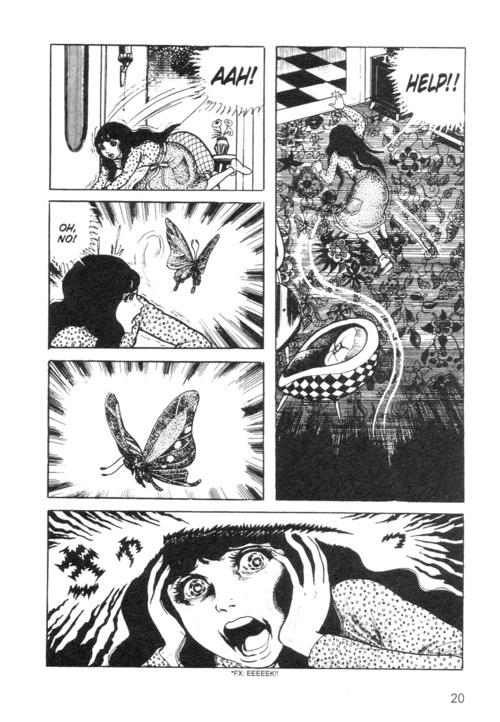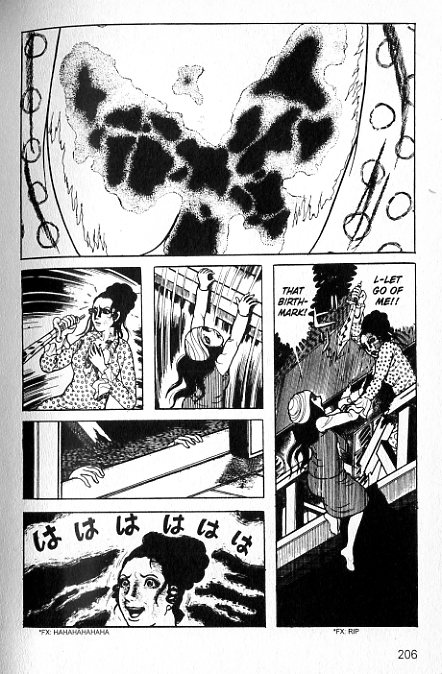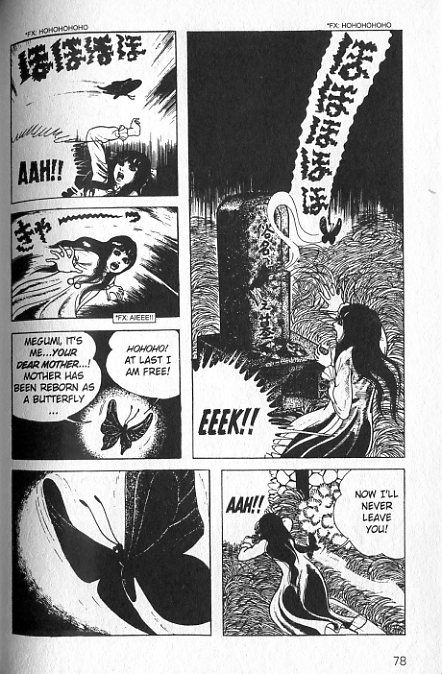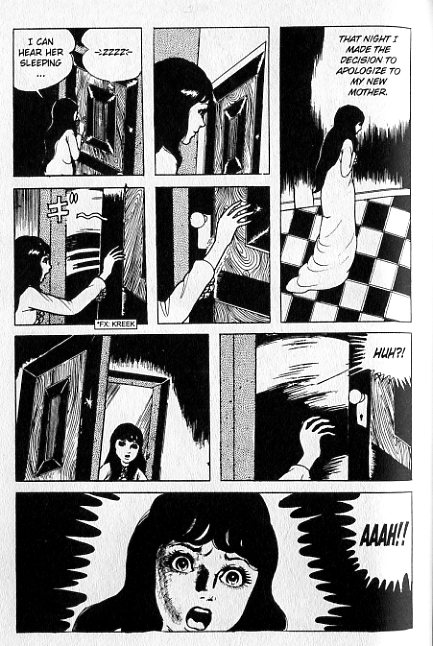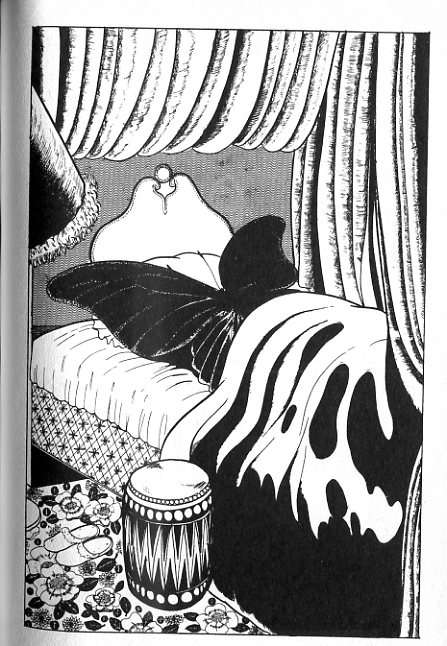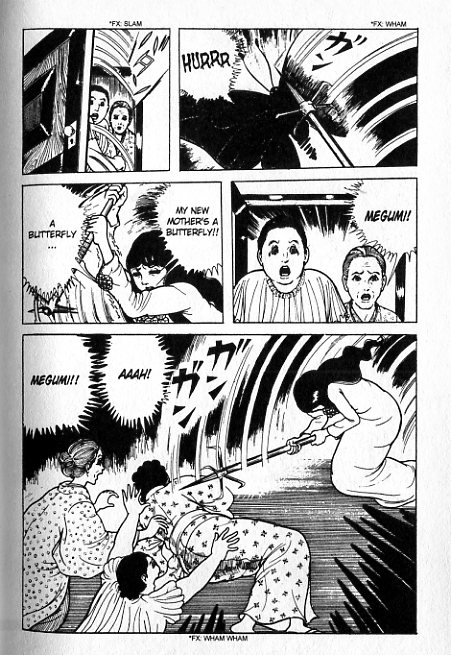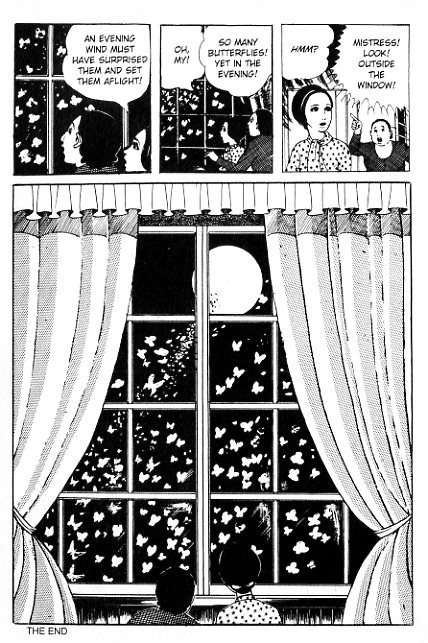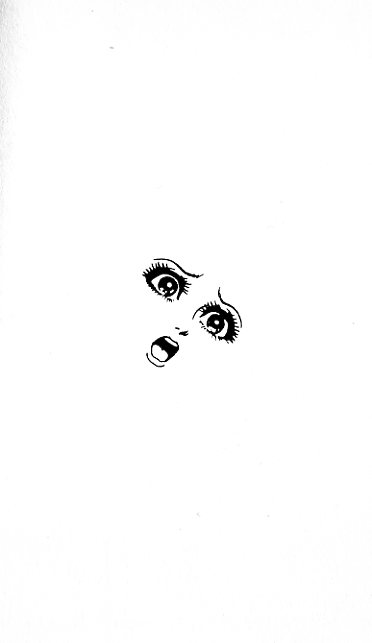A couple weeks back I talked a bit about the tiresomeness of the strong female character trope. And I don’t disavow that: strong female characters, who all know kung-fu and never take no shit, remain tiresome. But Megumi, the main character in Kazuo Umezu’s one-volume manga “Butterfly Grave,” reminds you why, tiresome as they are, those strong female characters are generally seen as preferable to the alternative.
Megumi is the alternative. She is not strong. She is weak…and holy shit is her drippy, unrelenting weakness incredibly annoying. Virtually all she does, throughout the entire manga, is whine, cower in tower, and then, sometimes, for variation, whine some more. Her one character trait is an overwhelming phobia of butterflies, and when she is not shrieking and running from some fluttering assailant, she is trembling and helplessly agonizing internally about how terrible it is that she is always shrieking and running from the fluttering assailants. When even Umezu tires of that, he has her start seeing phantom black butterflies everywhere, resulting in more cowering, additional agonizing, and, if you’re me, a fair amount of fervent wishing that the horror manga would get on with the horror and kill her off in some gruesome fashion — preferably with collateral damage including her colorless father, her colorless boyfriend, the colorless kids at her school, and perhaps (if you’ll forgive me) the banally uninventive manga-ka who has inflicted all of them upon me.
As this suggests, Megumi’s spinelessness, and consequent shapelessness, is more than just a personality trait; it’s a kind of miasma which infects the entire manga. Umezu’s Drifting Classroom, which focuses on the Bildungsroman of a male protagonist, has a grim, ineluctable structure, racing forward in an ever-rising body count towards an ever bleaker future. “Butterfly Grave”, on the other hand, vacillates in a sodden nowhere. There are events, and more events, but they never add up to anything or go anywhere. Megumi is scared by butterflies; Megumi is scared by the grotesque but harmless gardener; Megumi is scared by a dream in which her dead mother rises from the grave as a butterfly. The whole middle section of the manga is given over to little episodes where Megumi sees an ominous black butterfly, and then disaster strikes (a car loses its breaks; there’s an earthquake.) This seems to be building somewhere…but no. Umezu just abandons it. When Megumi’s fear of butterflies is eventually explained, her predictive powers aren’t so much rationalized as simply forgotten. The story — Megumi’s story — doesn’t matter, because she doesn’t really have a story. She just has the ritual repetition of terror and weakness.
Nonetheless, and almost despite itself, the manga does heave lugubriously into a kind of plot. Megumi’s mother (given to unaccountable fits of terror like Megumi herself) died soon after Megumi was born, killed in a fall from the balcony of the house. Eventually, Megumi’s father decides to remarry a woman he has known for a long time…a woman who, as it turns out, is evil, evil, evil. It is she, the new second mother, who killed Megumi’s actual mother, pushing her off the balcony as she clutched Megumi to protect her. In the climactic scene, this murder is recreated; the evil mother tries to push Megumi off the balcony, revealing in the process a butterfly shaped birthmark. Thus Megumi’s fear of butterflies — it’s all a infantile psychological thingee, don’t you know.
The explanation doesn’t make a whole lot of sense, but again narrative closure, or even coherence, isn’t really the point. On the contrary, narrative incoherence is the point. The butterfly “revelation” tends not to provide linear closure, but to turn the manga into a closed fuzzy circle — or perhaps a blurred shadow, like the birthmark itself. Megumi takes the place of her mother as victim. But the mother has also been insistently associated with the butterfly, as in this dream sequence.
Thus, mother and step-mother are butterflies, and mother and step-mother end up also being substitutes for each other. And if mother is Megumi, and mother is step-mother, then step-mother and Megumi are also the same…a point underlined when the step-mother, like the mother, and almost like Megumi, falls to her death from a height (a cliff face rather than a balcony, but still).
I’ve been reading several articles recently which reference the work of Nancy Chodorow, a feminist psychoanalyst who argues that female ego-formation is less complete or rigid than male ego-formation; that the boundaries of women’s selves are more permeable because daughters identify with mothers, and eventually with their own daughters/children. Whatever it’s application to real women, Chodorow’s ideas have an obvious application to “Butterfly Grave”, where Megumi both barely has a self and is transposed with multiple mothers, who in turn keep becoming dis-embodied and turned into soft, shadowy things, grotesque butterfly non-forms.
Throughout the manga, Megumi keeps asking herself “Why am I afraid of butterflies?” The answer, diegetically, is that she is afraid of her step-mother. The answer, thematically, is that she is afraid of her mother.
So why is she afraid of being her mother? Mothers are good things you’d think. Megumi’s mother sacrifices her life so her daughter won’t die in the fall from the balcony. This is initially described as an accident; Megumi crawled out into danger, and her mother rushed to save her.
The mother gives her life and saves Megumi…but if Megumi is the mother, or is to be the mother, then the sacrifice is also an imperative that she, Megumi, die — to be a mother is to give up the self. Thus, the mother is the victim of Megumi who causes her fall accidentally, and/or of the stepmother (who is also Megumi) who murders her. But the mother is also the murderer, the woman you will be who demands you give up your self. Mother murders daughter, daughter murders mother, in a perfect glob of girly-butterfly passive-aggressive doom.
In the manga, the step-mother hates Megumi’s mother because she wants her father — a neat Oedipal drama, if the step-mother is a stand-in for Megumi. But really there’s little energy invested in the het-plot, which seems mentioned only to show us how irrelevant it is. The real change in the step-mother’s behavior comes after Megumi’s attack on hert’s not love which leads to aggression, but loss of self — both in the sense that Megumi is not herself when she attacks, and in the sense that what provokes the attack is the step-mother not being herself, but an amorphous other, which is also Megumi.
The manga ends happily; the step-mother has killed herself, Megumi isn’t freaked out by butterflies anymore, and — significantly — Megumi has her own daughter, who isn’t afraid of butterflies either. The last image is of the mother and daughter looking calmly out the window at a group of butterflies flying past; white rather than black, the blurred, shapeless shapes are domesticated and contained in the comforting grid of window panes, and the domestic arc of the curtains.
Or that seems to be the last image. In fact, on the overleaf is one final drawing — Megumi’s frightened face, screaming, disappearing into whiteness.
It’s not clear how this image fits into the story narratively. But thematically and visually, it links Megumi to the white butterflies, and simultaneously replaces domesticity with dread. Maternal peace suddenly becomes merely a continuation of Megumi’s monotonous terror. Megumi’s happy ending is her worst fear; she’s finally a mother, and so her self — which was never anything but her terror — fades to white. Instead of a strong female character, Umezu gives us woman as mother, which is also, in this vision, woman as void.

